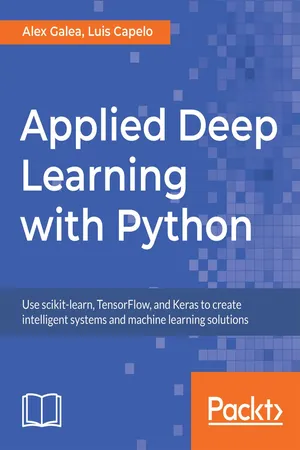
Applied Deep Learning with Python
Use scikit-learn, TensorFlow, and Keras to create intelligent systems and machine learning solutions
- 334 pages
- English
- ePUB (mobile friendly)
- Available on iOS & Android
Applied Deep Learning with Python
Use scikit-learn, TensorFlow, and Keras to create intelligent systems and machine learning solutions
About this book
A hands-on guide to deep learning that's filled with intuitive explanations and engaging practical examples
Key Features
- Designed to iteratively develop the skills of Python users who don't have a data science background
- Covers the key foundational concepts you'll need to know when building deep learning systems
- Full of step-by-step exercises and activities to help build the skills that you need for the real-world
Book Description
Taking an approach that uses the latest developments in the Python ecosystem, you'll first be guided through the Jupyter ecosystem, key visualization libraries and powerful data sanitization techniques before we train our first predictive model. We'll explore a variety of approaches to classification like support vector networks, random decision forests and k-nearest neighbours to build out your understanding before we move into more complex territory. It's okay if these terms seem overwhelming; we'll show you how to put them to work.
We'll build upon our classification coverage by taking a quick look at ethical web scraping and interactive visualizations to help you professionally gather and present your analysis. It's after this that we start building out our keystone deep learning application, one that aims to predict the future price of Bitcoin based on historical public data.
By guiding you through a trained neural network, we'll explore common deep learning network architectures (convolutional, recurrent, generative adversarial) and branch out into deep reinforcement learning before we dive into model optimization and evaluation. We'll do all of this whilst working on a production-ready web application that combines Tensorflow and Keras to produce a meaningful user-friendly result, leaving you with all the skills you need to tackle and develop your own real-world deep learning projects confidently and effectively.
What you will learn
- Discover how you can assemble and clean your very own datasets
- Develop a tailored machine learning classification strategy
- Build, train and enhance your own models to solve unique problems
- Work with production-ready frameworks like Tensorflow and Keras
- Explain how neural networks operate in clear and simple terms
- Understand how to deploy your predictions to the web
Who this book is for
If you're a Python programmer stepping into the world of data science, this is the ideal way to get started.
Frequently asked questions
- Essential is ideal for learners and professionals who enjoy exploring a wide range of subjects. Access the Essential Library with 800,000+ trusted titles and best-sellers across business, personal growth, and the humanities. Includes unlimited reading time and Standard Read Aloud voice.
- Complete: Perfect for advanced learners and researchers needing full, unrestricted access. Unlock 1.4M+ books across hundreds of subjects, including academic and specialized titles. The Complete Plan also includes advanced features like Premium Read Aloud and Research Assistant.
Please note we cannot support devices running on iOS 13 and Android 7 or earlier. Learn more about using the app.
Information
Data Cleaning and Advanced Machine Learning
- Plan a machine learning classification strategy
- Preprocess data to prepare it for machine learning
- Train classification models
- Use validation curves to tune model parameters
- Use dimensionality reduction to enhance model performance
Preparing to Train a Predictive Model
Determining a Plan for Predictive Analytics
- Look at the available data to understand the range of realistically solvable business problems. At this stage, it might be too early to think about the exact problems that can be solved. Make sure you understand the data fields available and the
time frames they apply to. - Determine the business needs by speaking with key stakeholders. Seek out a problem where the solution will lead to actionable business decisions.
- Assess the data for suitability by considering the availability of sufficiently diverse and large feature space. Also, take into account the condition of the data: are there large chunks of missing values for certain variables or time ranges?
- Is the training data labeled with the target variable we want to predict?
Table of contents
- Title Page
- Copyright and Credits
- Packt Upsell
- Contributors
- Preface
- Jupyter Fundamentals
- Data Cleaning and Advanced Machine Learning
- Web Scraping and Interactive Visualizations
- Introduction to Neural Networks and Deep Learning
- Model Architecture
- Model Evaluation and Optimization
- Productization
- Other Books You May Enjoy